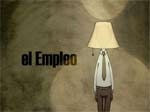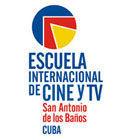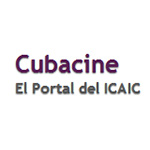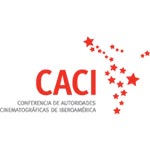 “Nuestro objetivo final es nada menos que lograr la integración del cine latinoamericano.
Así de simple, y así de desmesurado”.
“Nuestro objetivo final es nada menos que lograr la integración del cine latinoamericano.
Así de simple, y así de desmesurado”.
Gabriel García Márquez
Presidente (1927-2014)


-

Es hora de empezar a construir una animación latinoamericanaPor Yaima Leyva MartínezEl empleo ha sido el cortometraje de animación latinoamericano más premiado en 2008. Ya suman 24 los premios que ha alcanzado; participó en 30 festivales de cine y animación. Entre los lauros más importantes están el Gran Primer Premio en el Festival Internacional de Animación Anim´est (Bucarest, Rumanía), Primer Premio al Mejor Cortometraje de Animación Internacional en el Festival La Boca del Lobo (Madrid, España), Primer Premio en el Festival Expotoons (Buenos Aires, Argentina) y Primer Premio Coral de Animación en el 30 Festival Internacional del Nuevo Cine Latinoamericano de La Habana.
A propósito de la participación de El empleo en el Festival de La Habana, sus realizadores Santiago Bou Grasso (dirección, fotografía, producción, edición, animación), y Patricio Gabriel Plaza (guión, fotografía, sonido) respondieron a dos voces un puñado de interrogantes.
Ambos trabajan como ilustradores free lance y animadores independientes. ¿Por qué deciden hacer cine de animación?
Patricio y yo compartimos un desarrollo artístico muy parecido y a la vez unido. Yo estaba estudiando diseño en comunicación visual en la universidad y en el segundo año de la carrera realicé un curso de dibujos animados y descubrí qué era lo que quería hacer el resto de mi vida. Patricio desde chico siempre tuvo en claro que iba a hacer animación, y los dos desembocamos en el mismo estudio donde nos formamos juntos como animadores. Luego de estar trabajando mucho tiempo en distintos estudios haciendo varios largometrajes y publicidad, cada vez se nos hizo más impostergable la necesidad de empezar a producir cosas nuestras, alejándonos de la mirada estereotipada de la animación comercial para usar el arte de la animación como una herramienta para volcar inquietudes artísticas personales. La animación para nosotros es un arte maravilloso y super potencial, tanto desde lo artístico-expresivo como por su fuerza para comunicar ideas. El corto lo hicimos paralelamente al trabajo que teníamos en un estudio como animadores y, con gran esfuerzo, en los tiempos libres que nos quedaban, nos poníamos a trabajar en él. Luego nos otorgaron una Beca del Fondo Nacional de las Artes y pudimos terminarlo. Ahora los dos seguimos trabajando cada uno por su lado como ilustradores free lance, ya que todavía no hay en Argentina un apoyo concreto para los realizadores de animación, ya sea estatal o industrial, que sostenga a un creador como para que pueda dedicarse exclusivamente a realizar sus propias producciones. Pero la idea es seguir produciendo animación independiente, comprometidos con nuestra realidad y con lo queremos decir.¿De dónde partió la idea original de El empleo?
El empleo es una pequeña metáfora del uso del hombre por el hombre, inspirada en parte por la observación de la realidad y en parte por experiencias personales. En el mundo capitalista, la deshumanización del hombre es algo naturalizado, el valor de las personas se mide por lo que producen o lo que consumen. De ahí surge la idea de mostrar a los seres humanos como objetos que cumplen un rol definido, carentes de toda humanidad. Al principio cuando concebí la idea original del corto, tenía un tono más surrealista y más ligado al lenguaje clásico de la animación. Luego, con Santiago, le dimos un tono más naturalista, más cotidiano. Esto dotó al corto de cierta crudeza en el ambiente y más potencia, que era la manera a través de la cual queríamos acercarnos al espectador. Nuestra intención era que el corto no se redujera a un chiste o a un episodio cómico, sino que fuera un comentario más ácido y crítico sobre la sociedad.¿A qué creen se deben todos los premios obtenidos hasta la fecha por El empleo?
La fuerza de la idea es un pilar fundamental del corto. No creo que haya nadie que participe de la realidad social actual que no se sienta reflejado en mayor o menor medida en la temática. Y por otro lado, la elección estética y el desarrollo narrativo la han acompañado. No abundan los cortos independientes realizados en 2D tradicional. Nos gusta ir (cuando podemos) a las proyecciones de cortos en los distintos festivales donde participó. Allí vemos que la reacción de la gente es recurrente; a lo largo del corto, se escuchan risas causadas por lo surreal y satírico de las situaciones, y al llegar el final se genera un notable silencio en la sala. También hay lugares concretos donde el corto ha tenido una recepción muy positiva, en especial en Europa del Este, donde ganamos el primer premio en el festival Anim’est, de Rumanía. Es un poco impredecible y a la vez apasionante ver cómo una obra que uno realiza desde Latinoamérica puede hacer eco en las sensibilidades de culturas tan lejanas y en apariencia distintas, lo cual comprueba que hay temas y problemáticas que son universales.¿Por cuáles creadores de la animación contemporánea se sienten influenciados?
Nos sentimos influenciados por muchos realizadores de animación de autor. Sobre todo, por aquellos que entienden la animación como una forma de expresión artística y un medio para comunicar. Entre ellos están Johanna Quinn, Michaela Pavlátová, Igor Kovalyov, Michael Dudok de Wit, Paul Driessen, y la escuela de animación checa y rusa en general. En Europa hay mucha historia de realización de animación independiente con una orientación artística o de autor, no netamente comercial, porque hay más apoyo a la producción por parte de los estados. También es de destacar el trabajo a nivel técnico de las grandes producciones de animación norteamericanas y japonesas, pero siempre siendo conscientes que, más evidente en las películas norteamericanas, tienen un claro fin político de colonización cultural. Esto es peligroso, sobre todo para los chicos, si uno consume inocentemente ese tipo de películas.¿Qué opinión tienen sobre el estado actual de la animación latinoamericana?
Por la información que tenemos, los países donde se realiza más animación en Latinoamérica son Argentina, Brasil, México y Cuba. Lamentablemente, no hay una industria consolidada de animación en Latinoamérica, por lo cual los esfuerzos de producción siempre son aislados. En Argentina, por ejemplo, el año pasado se realizaron tres largometrajes de animación, pero actualmente los estudios que los realizaron están cerrados. Al no haber continuidad en la producción ni una industria que la sustente, luego de cada película muchos animadores se quedan sin trabajo. Otro método muy frecuente en Latinoamérica es la tercerización de trabajo para Europa y Estados Unidos. Como aquí hay muy buenos artistas y somos baratos, se suele trabajar para empresas extranjeras, sacrificando así nuestra propia identidad creativa y artística, quedando siempre relegados a reproducir personajes e historias que nos son ajenos. En cuanto a la animación independiente, lugar al que sentimos que pertenecemos, se dificulta mucho más la producción de animación de autor en Latinoamérica en relación a otros continentes, principalmente por la ausencia de un estado que apoye la producción de animación de autor, y por la falta de distribución de los canales de televisión locales, que están más abocados a comprar animación norteamericana que a difundir la producción latina. Sin un estado presente que apoye las realizaciones nacionales y un sistema de medios televisivos que difunda las producciones locales y regionales, se vuelve muy dificultoso poder subsistir haciendo animación independiente. Por eso, generalmente los que nos dedicamos a ello trabajamos paralelamente en ilustración o historieta, y producimos animación en el tiempo que nos queda, autofinanciándonos. Por suerte, últimamente en Latinoamérica, con la aparición de los nuevos gobiernos progresistas, está habiendo un mayor apoyo a la cultura, que se traduce en la aparición de nuevos festivales de cine, entre ellos varios de animación. Los festivales terminan siendo la médula espinal de todo animador independiente, ya que solo a través de ellos uno puede dar a conocer su obra al público de todo el mundo. De ahí surge la importancia sustancial que tienen los festivales para cualquier animador independiente.Próximos proyectos…
Patricio está desarrollando diferentes ideas para sus próximos cortometrajes. Yo, por mi parte, ya estoy arrancando con un cortometraje en stop motion, de animación con muñecos, titulado Padre (donde también va a participar Patricio). Ya con la preproducción lista, estoy terminando de juntar el presupuesto para comenzar la producción. Es un corto muy ambicioso a nivel de realización, que va a abordar la relación opresiva entre una hija y su padre militar, contextualizado en el final de la dictadura militar y el retorno a la democracia de la Argentina de 1983. Nos parece valioso que la animación también se aboque a contar nuestras historias y reflejar nuestra identidad. En ese sentido, es destacable el trabajo de Cuba, con la obra de animadores como Juan Padrón, conscientes desde siempre de la importancia de crear personajes que sean fieles a la historia, las realidades y las luchas de sus propios pueblos. Es terrible que en nuestros países aun se sigan emulando los modos de contar y el imaginario de la animación norteamericana y japonesa. Ya es hora de empezar a construir una animación latinoamericana, porque tenemos un pueblo maravilloso y muchas cosas que decir. It is time to start creating a Latin American animation
It is time to start creating a Latin American animation
By Yaima Leyva Martínez
El empleo has been the most awarded Latin American animation short film in 2008. It has already got 24 prizes; it has participated in 30 film and animation festivals. Among its most important awards are the Great Prize at the International Animation Festival Anim´est (Bucharest, Rumania), First Prize to the best Animation short film at the Expotoons Festival, (Buenos Aires, Argentina) and First Prize (Coral) for animation at the International Film Festival of the New Latin American Cinema of Havana.
With regard to the participation of El empleo in the Havana Festival, the filmmakers, Santiago Bou Grasso (direction, photography, production, editing, animation), and Patricio Gabriel Plaza (script, photography, sound) answered the following questions.
Both of you work as free lance illustrators and independent animation filmmakers. Why did you decide to make animation films?
Patricio and I share a very similar and united artistic development. I was studying design in visual communication at the university, when I was a sophomore I took a course on cartoon animation and discovered that was what I wanted to do for the rest of my life. Patricio always knew, since he was a child that he wanted to make animations, so both of us ended up at the same studio where we took our training as animation filmmakers together. After working for a long time in different studios, doing some feature films and advertising, the need to produce our own work became peremptory; we needed to get away from the stereotyped perspective of commercial animation in order to use the art of animation as a tool to express our personal and artistic expectations. For us animation is a wonderful and very powerful art, not only for the artistic-expressive aspect but also for its strength to communicate ideas. The short film was done at the same time as we were doing our work at a studio, with great efforts, we would work on it in our free time. Later, we won a scholarship from the National Funding for Arts and we were able to finish it. Nowadays each of us works independently as free lance illustrators, since there is not yet a concrete support for animation filmmakers in Argentina, neither industrial or from the state, which can support an artist in a way that we can devote our time exclusively to create our own productions. But our idea is to continue to produce animation films independently, committed to our reality and the things we want to say.
Where does the original idea of El empleo come from?
El empleo is a little metaphor of how man uses man; it is partially inspired by the observation of reality and partially by personal experiences. In the capitalist world, man’s dehumanization is something naturalized, people’s value is measured by the amounts they produce or consume. That is where the idea of showing human being as objects, playing a particular role, lacking humanity, comes from. At the beginning, when I conceived the original idea of the short film, it had a more surrealist tone, more linked to the classical language of animation. Later, with Santiago, we achieved a more naturalist, everyday tone. This endowed the film with certain crudeness in the atmosphere, more strength, and that was the way in which we intended to address the spectator. Our intention was for the film not to become a joke or a funny episode, but an acid and critical comment about society.
Which are, in your opinions, the reasons why El empleo has been such a prize-winner film?
The strength of the idea has been a fundamental pillar in the film. I do not think there is anybody who is part of the present social reality who does not feel reflected to some extend in this theme. And on the other hand, it has been accompanied by the aesthetic selection and the development of the narrative. There are not many independent short films made in traditional 2D. We like to attend (when we have the chance) the exhibition of short films in the different festivals where I participate. We notice that people’s reaction is recurrent; through the film, you listen to the laughter caused by the surreal and satirical situations, and at the end there is a noticeable silence at the movie theatre. There are also specific places where the short film has had a very positive reception, especially in Eastern Europe, where we won First Prize at the festival Anim’est, of Rumania. It is a little unpredictable and at the same time exciting to see how a piece done from Latin America can have an echo in such distant and apparently different cultures, which proves that there are topic and problems which are universal.
Who are the contemporary creators of animation films who have an influence in your work?
We feel influenced by many filmmakers who do author’s work of animation. Mainly by those who understand animation as a form of artistic expression and a means to communicate. Among them we can mention Johanna Quinn, Michaela Pavlátová, Igor Kovalyov, Michael Dudok de Wit, Paul Driessen, and the Russian and Czech schools in general. In Europe, there is a long history of independent animation filmmaking with an artistic or author’s orientation, not purely commercial, because there is more support to the productions by the states. It is also fair highlighting the technical level of the big American and Japanese animation productions, but we have to be aware that, more evidently in the American productions, they have the political aim of cultural colonization. This is dangerous, above all for children, if those films are consumed innocently.
What is your opinion about the present status of Latin American animation?
Due to the training we have, the Latin American countries where more animation is made are Argentina, Brazil, Mexico and Cuba. Unfortunately, there is not a well-established industry for animation in Latin America, and therefore the production efforts are always isolated. In Argentina, for example, three animation feature films were made last year but nowadays the studios where they were made are closed. Since there is not continuity in the productions or an industry supporting it, after each film many animator filmmakers are jobless. Another frequent method in Latin America is to outsource work to Europe and the United States. Since there are good artists here and we are cheap, people are used to working for foreign enterprises, thus sacrificing our own creative and artistic identity, always relegated to reproducing characters and stories that are alien to us. Concerning independent animation, we feel that is where we belong, the production of author’s animation becomes even more difficult in Latin America than in other continents, mainly for the absence of a state that supports the production of author’s animation, and for the lack of distribution in the local television channels, which are more headed to buying American animation than promoting Latin American productions. Without the presence of a state that supports national productions and a system of television media promoting local and regional productions, surviving as an independent animation filmmaker becomes very difficult. That is why those of us who do it, work at the same time in illustration or comics, and produce animation in the time we have left and we self finance our productions. Luckily, with the appearance of new progressive governments in Latin America, there is more support to culture lately, and as a result, there are new cinema festivals, among them there are some for animation productions. Festival end up being the spinal cord of independent animation filmmakers, since it is only through them that our work can be known by the public around the world. That is where the substantial importance of festivals for any independent animation filmmaker arises.
Future projects…
Patricio is developing different ideas for his next short films. Personally, I am beginning to work in a stop-motion short film, it is animation using puppets the title is Padre (Father) and Patricio is going to participate too. I now have the pre-production phase ready and I am putting the budget together for production. We are making an ambitious short film, it will deal with the oppressive relationship between a daughter and a father who is a military, the context is the final stage of the military dictatorship and the return of democracy in Argentina in1983. We believe it is valuable that animation also deal with those stories that reflect our identity. In that sense, the work in Cuba is outstanding, with the works of animation filmmakers such as Juan Padrón, who have always been aware of the importance of creating characters that are true to the history, reality and the struggles of their own countries. It is terrible that in our countries people continue to follow the way of telling stories and the imaginary of animation in the Japanese and American styles. It is time to start creating a Latin American animation, because we have wonderful people and many things to say.
















